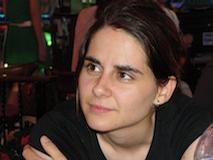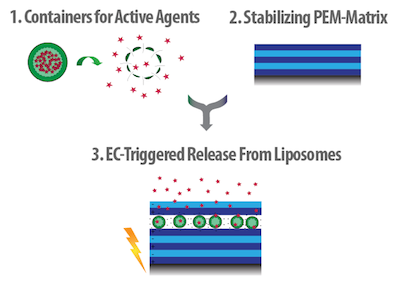Graf, Norma, Dr.

ETH Zürich
PhD Thesis 2012
Master Thesis 2007
Research
I am basically working on a electroactive platform for the controlled release of active agents into cells adsorbed on a polyelectrolyte multilayer.
- Background Information:
Influencing biological processes in vivo such as DNA expression or osseointegration of implants, or in vitro cell cultures requires precise control over the involved parameters like time, dose and local control of the substance delivery. Therefore, its important to trigger the release of potential drugs in a very controlled manner.
- My Work:
My project consists in the developement, creation and appllication of a novel platform that could be used for drug delivery or other biomedical applications. My platform consists basically of 3 components (see Figure):
1. Containers that encapsulate the agent which will be delivered, in my case these are negatively charged liposomes
2. A matrix where the containers can be embedded. The matrix increases the stability of the platform and protects the vesicles from unwanted rupture. In my case the matrix consists of polyelectrolyte mulitlayers which are very well suited due to a set of unique properties.
3. A trigger mechanism that allows the controlled release of the agent from the containers. For my platform i decided this will be electrochemically due to a lot of advantages over other techniques such as its straightforward use, its versatility and the ease of precise control.

Possible Projects for Master or Semester Thesis
• One option would be to test if it is possible to grow human cells on the platform. If it’s possible one would investigate if they „eat“ the active agents after the release. This could be done by using active agents that are not harmful for the cells and show fluorescence in the cell.
Here, your work would (apart from general lab work) focus on
- Cell culturing
- Microscopy
- Confocal fluorescence microscopy
• Another option would be to pattern the substrate. The substrate is the working electrode for the electrochemically induced release. If this substrate consists of several individually adressable electrodes, it is possible to release different agents at different time points. This could be observed by filling different fluorescent dyes into different vesicles and observe the release by fluorescent microscopy.
Here your work would (apart from general lab work) focus on
- Microfabrication
- Atomic force microscopy
- Confocal fluorescence microscopy
• A third option would be to investigate more the details of the buildup of the platform. For example, one of the ideas is to see if it’s possible to incorporate more than just one layer of vesicles into the system. This could dramatically increase the loading capacity of the system. Furthermore, i would like to deep freeze one of the samples and then investigate it by electron microscopy.
Here your work would (apart from general lab work) focus on
- Quartz crystal microbalance
- Atomic force microscopy
- Confocal fluorescence microscopy
- Cryo TEM (transmission electron microscopy)
Publications
• Spontaneous Formation of a Vesicle Multilayer on Top of an Exponentially Growing Polyelectrolyte Multilayer Mediated by Diffusing Poly-l-lysine
Norma Graf, Elsa Thomasson, Alexander Tanno, Janos Vörös, Tomaso Zambelli
Journal of Physical Chemistry B, 2011
• From nanodroplets to continuous films: how the morphology of polyelectrolyte multilayers depends on the dielectric permittivity and the surface charge of the supporting substrate
Orane Guillaume-Gentil, Raphael Zahn, Saskia Lindhoud, Norma Graf, János Vörös and Tomaso Zambelli
Soft Matter, 2011, 7, 3861
• Electroactive platform for stimulated release from liposomes embedded in polyelectrolyte multilayers
N. Graf, F. Albertini, T. Petit, E. Reimhult, J. Vörös, T. Zambelli
Advanced Functional Materials, 2011, 21, 1666-1672
• Global and Local View on the Electrochemically Induced Degradation of Polyelectrolyte Multilayers: from Dissolution to Delamination
O. Guillaume-Gentil, N. Graf, F. Boulmedais, P. Schaaf, J. Vörös, and T. Zambelli
Soft Matter, 6, 4246–4254, 2010.
• Electrochemically controlled deposition and dissolution of PLL/DNA multilayers
L. Diéguez, N. Darwish, N. Graf, J. Vörös, T. Zambelli
Soft Matter 5, 2415-2421, 2009.
Oral Presentations
• Electrochemically stimulated dye-release from liposomes embedded in a polyelectrolyte multilayer
Norma Graf, Janos Vörös, Tomaso Zambelli;
ISP International Symposium on Polyelectrolytes, 14.-16.11.2010, Shanghai, China
• Electrochemically stimulated release from liposomes embedded in a polyelectrolyte multilayer
Norma Graf, Francesco Albertini, Tristan Petit, Janos Vörös, Tomaso Zambelli
MRC Graduate Symposium, 10.05.2010, ETH Zürich, Switzerland
• Towards electrically induced release of bioactive molecules into living cells
Norma Graf, Francesco Albertini, Tristan Petit, Janos Vörös, Tomaso Zambelli;
WACBE World Congress on Bioengineering 2009, 26 – 29 July 2009, The Hong Kong Polytechnic University, China
Poster Presentations
• Electrochemically triggered Release of Dyefrom Liposomes Embedded in Polyelectrolyte Multilayers
N.M. Graf, F. Albertini, T. Petit, J. Vörös, T. Zambelli
European Material Research Symposium (EMRS), 9.-14.5.2011, Nice, France
• Electrochemically Triggered Release of Bio-active Molecules from Liposomes
N. M. Graf, J. Vörös, T. Zambelli
20th International Symposium on Bioelectrochemistry and Bioenergetics, 10.-14.05.2009, Sibiu, Romania
This Poster received the "BES 2009 Best Poster" Award
• Electrochemically triggered Release of Bio-active Molecules from Liposomes
N.M. Graf, F. Pianezzi, J. Vörös, T. Zambelli
Joining Forces: Sensing and Manipulating in Live Cells, 07.11.2008, Zürich, Switzerland
• Electrochemically Triggered Rupture of Phosphocholine Vesicles
N.M. Graf, F. Pianezzi, J. Vörös, T. Zambelli
SBE's 4th International Conference on Bioengineering and Nanotechnology, 22.-24.07.2008, Dublin, Ireland
• Polyelectrolyte Multilayers as Interface for Biomedical Applications
N.M. Graf, O. Gillaume-Gentil, D. Abbruzzese, R. Zahn, J. Vörös, T. Zambelli
7th International Symposium on Polyelectrolytes, 16.-19.6.2008, Coimbra, Portugal
Student Projects
• Study of a polyelectrolyte multilayer based release system for spatial and temporal release control
Alexandre Dochter (Master Thesis)
• Stretching as an Alternative Triggering Mechanism for Dye Release from Liposomes Embedded in Polyelectrolyte Multilayers
Luca Hirt (Semester Thesis)
• Design Strategies for Electrochemically Triggered Release of Dyes to Cells
Alexander Tanno (Semester Thesis)
• Investigation of Lipid Composition for pH-Sensitive Liposomes
Francesco Albertini (Semester Thesis)
• Protocols for Embedding Intact Vesicles into a Polyelectrolyte Multilayer
Tristan Petit (Semester Thesis)
